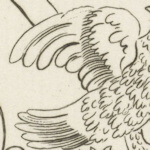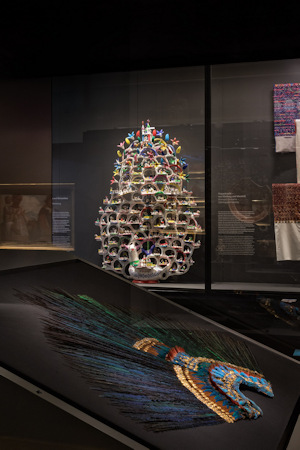
One of the popular images of the Aztec culture consists of a priest or emperor in a large feathered headdress. The world’s last remaining example resides in the Weltmuseum Wien’s permanent exhibition.
- “Penacho” made from the feathers of the quetzal and other birds
- Interwoven with gold and other materials
- Origins and owner largely unknown
- Constructed in the very early 1500s
- Also known as the crown of Montezuma and other titles
- But no evidence for such a connection
- Presence in Vienna somewhat contentious
- Book Weltmuseum tickets*
- See also:
The Penacho

(The quetzal-feather headdress; press photo © KHM-Museumsverband)
The list of components of this Aztec headdress already gives a reasonable indication of its worth: gold, gilt bronze, leather, paper, cotton and other fibres, and feathers from the quetzal, cotingas, roseate spoonbill, squirrel cuckoo and kingfisher.
Combine these ingredients into a glorious 116cm by 175cm panoply of shimmering blues, greens and gold, throw in an association with an iconic Mexican culture, add a twist of Habsburg history, and you have a quite remarkable piece of art.
(Incidentally, the quetzal bird itself plays its own special role in Aztec culture through, for example, an association with Quetzalcoatl, an important deity.)
Even today, the headdress still retains much of its original colour, and you can imagine the stunning physical impression it would have made when worn, even without any spiritual implications.
Acquisition history

(Archduke Ferdinand II of Tyrol brought the Penacho to Austria; image courtesy of the Rijksmuseum)
As you might suspect, much presumably happened between Aztec artisans putting together the headdress in early 16th-century Mexico and it appearing in an ethnographic museum in 21st century Vienna.
The Penacho somehow came into the possession of Archduke Ferdinand II of Tirol (1529-1595), a Habsburg scion who ruled, for example, territories in what is now the west of Austria.
Ferdinand was a major collector, and much of his diverse stockpile of art and artefacts eventually found its way to Vienna. His remarkable set of miniature portraits, for example, covers the walls of the permanent coin exhibition at the Kunsthistorisches Museum.
Ferdinand’s acquisitional efforts also form a core part of the astonishing Kunstkammer chamber of wonders (also at the Kunsthistorisches Museum).
The feather headdress eventually ended up in Vienna’s ethnographic museum (now the Weltmuseum) in the early 20th century.
Not that people always grasped the true nature of the feathered item in the Archduke’s collection.
An inventory taken in 1596, for example, marked it down as a Moorish hat. This description morphed into, for example, an Indian hat and an Indian apron in later documentation efforts.
The correct interpretation of the Penacho as a quetzal feather headdress of Mexican origin first appeared in the mid-19th century.
Even as this assessment gradually received universal approval, the exact origin of the headdress remained a matter of dispute. Many still consider it a former possession of the Aztec emperor, Montezuma II, though this perhaps owes more to wishful thinking than analysis. Truth is, nobody really knows.
Art historians do know, however, that many such feather headdresses found use in the higher echelons of Aztec society and religion. This is where the true value of the Vienna headdress comes to the fore: no other examples have survived.
As such, the Weltmuseum’s exhibit is unique.
Given that status, you might wonder why Mexico doesn’t want the Penacho back.
They do. Sort of.

(The headdress at its location in the Mesoamerica gallery of the Weltmuseum; press photo © KHM-Museumsverband)
A wish for the return of the headdress has led to some “conversations” between Mexico and Austria.
While the issue of returning the item remains, the prospect of this actually happening seems unlikely after a 2012 scientific report revealed that transporting the headdress would almost certainly lead to damage.
This explains why in 2021, for example, the museum turned down a request from Mexico to loan out the headdress for the 500th anniversary of the fall of the Aztec capital, Tenochtitlan.
In early 2022, activists swapped out the museum’s audio guides for their own featuring a different interpretation of the exhibit.
This intervention led to fresh calls to reexamine the prospect of repatriation in the light of technological advances in the transport of delicate items.
Where to see the headdress
The Penacho occupies its own standalone display case in the middle of the “Stories from Mesoamerica” area of the Weltmuseum. The same room has a stuffed Quetzal bird in it, too, should you wish to see what the feathers look like when still attached to their owner.
A large touchscreen allows you to take a close look at the headdress and learn about its construction, conservation, and history, as well as explore the connections between Austria and Mexico.
You might wonder at any historical connection between the two countries, but Mexico was, for example, briefly ruled in the 1860s by the Habsburg Archduke Ferdinand Maximilian: brother of Emperor Franz Joseph.
Address: Heldenplatz, 1010 Vienna